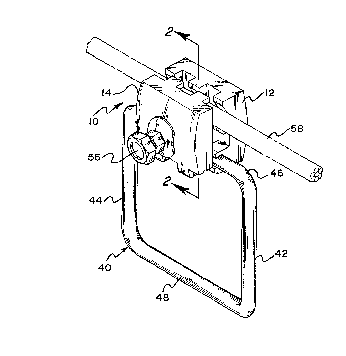Une partie des informations de ce site Web a été fournie par des sources externes. Le gouvernement du Canada n'assume aucune responsabilité concernant la précision, l'actualité ou la fiabilité des informations fournies par les sources externes. Les utilisateurs qui désirent employer cette information devraient consulter directement la source des informations. Le contenu fourni par les sources externes n'est pas assujetti aux exigences sur les langues officielles, la protection des renseignements personnels et l'accessibilité.
L'apparition de différences dans le texte et l'image des Revendications et de l'Abrégé dépend du moment auquel le document est publié. Les textes des Revendications et de l'Abrégé sont affichés :
| (12) Brevet: | (11) CA 2189578 |
|---|---|
| (54) Titre français: | CONNECTEUR ELECTRIQUE A ARTICULATION |
| (54) Titre anglais: | HINGED ELECTRICAL CONNECTOR |
| Statut: | Périmé et au-delà du délai pour l’annulation |
| (51) Classification internationale des brevets (CIB): |
|
|---|---|
| (72) Inventeurs : |
|
| (73) Titulaires : |
|
| (71) Demandeurs : |
|
| (74) Agent: | BORDEN LADNER GERVAIS LLP |
| (74) Co-agent: | |
| (45) Délivré: | 2000-07-18 |
| (22) Date de dépôt: | 1996-11-04 |
| (41) Mise à la disponibilité du public: | 1997-05-21 |
| Requête d'examen: | 1996-11-04 |
| Licence disponible: | S.O. |
| Cédé au domaine public: | S.O. |
| (25) Langue des documents déposés: | Anglais |
| Traité de coopération en matière de brevets (PCT): | Non |
|---|
| (30) Données de priorité de la demande: | ||||||
|---|---|---|---|---|---|---|
|
Un connecteur électrique comprend un premier élément de mâchoire possédant une surface interne, une surface externe, un premier et un deuxième bout. Le premier élément de mâchoire possède une portion courbe formée sur la surface interne adjacente au premier bout. Un deuxième élément de mâchoire possède une surface interne, une surface externe, un premier et un deuxième bout. Le deuxième élément de mâchoire possède une portion courbe formée sur la surface interne adjacente au premier bout. Une borne se présentant sous forme d'un étrier est fixée entre les deuxièmes bouts des premier et deuxième éléments de mâchoire. L'étrier présente un écart qui le traverse. Un élément de butée fait saillie du deuxième bout du premier élément de mâchoire. L'élément de butée est positionné dans l'écart de l'étrier afin d'empêcher tout déplacement axial de ce dernier le long du connecteur électrique.
An electrical connector includes a first jaw member that has an inside surface, an outside surface, a first end and a second end. The first jaw member further has a curved portion formed on the inside surface adjacent the first end. A second jaw member has an inside surface, an outside surface, a first end and a second end. The second jaw member also has a curved portion formed on the inside surface adjacent the first end. A terminal in the form of a stirrup is secured between the second ends of the first and second jaw members. The stirrup has a gap formed therethrough. Projecting from the second end of the first jaw member is a stop member. The stop member is positioned between the gap in the stirrup in order to prevent axial movement of the same along the electrical connector.
Note : Les revendications sont présentées dans la langue officielle dans laquelle elles ont été soumises.
Note : Les descriptions sont présentées dans la langue officielle dans laquelle elles ont été soumises.

2024-08-01 : Dans le cadre de la transition vers les Brevets de nouvelle génération (BNG), la base de données sur les brevets canadiens (BDBC) contient désormais un Historique d'événement plus détaillé, qui reproduit le Journal des événements de notre nouvelle solution interne.
Veuillez noter que les événements débutant par « Inactive : » se réfèrent à des événements qui ne sont plus utilisés dans notre nouvelle solution interne.
Pour une meilleure compréhension de l'état de la demande ou brevet qui figure sur cette page, la rubrique Mise en garde , et les descriptions de Brevet , Historique d'événement , Taxes périodiques et Historique des paiements devraient être consultées.
| Description | Date |
|---|---|
| Le délai pour l'annulation est expiré | 2016-11-04 |
| Lettre envoyée | 2015-11-04 |
| Inactive : CIB de MCD | 2006-03-12 |
| Accordé par délivrance | 2000-07-18 |
| Inactive : Page couverture publiée | 2000-07-17 |
| Déclaration du statut de petite entité jugée conforme | 2000-04-12 |
| Préoctroi | 2000-04-12 |
| Inactive : Taxe finale reçue | 2000-04-12 |
| Lettre envoyée | 1999-10-20 |
| Un avis d'acceptation est envoyé | 1999-10-20 |
| Un avis d'acceptation est envoyé | 1999-10-20 |
| Inactive : Approuvée aux fins d'acceptation (AFA) | 1999-09-29 |
| Inactive : Renseign. sur l'état - Complets dès date d'ent. journ. | 1998-04-21 |
| Inactive : Dem. traitée sur TS dès date d'ent. journal | 1998-04-21 |
| Demande publiée (accessible au public) | 1997-05-21 |
| Toutes les exigences pour l'examen - jugée conforme | 1996-11-04 |
| Exigences pour une requête d'examen - jugée conforme | 1996-11-04 |
Il n'y a pas d'historique d'abandonnement
Le dernier paiement a été reçu le 1999-10-07
Avis : Si le paiement en totalité n'a pas été reçu au plus tard à la date indiquée, une taxe supplémentaire peut être imposée, soit une des taxes suivantes :
Les taxes sur les brevets sont ajustées au 1er janvier de chaque année. Les montants ci-dessus sont les montants actuels s'ils sont reçus au plus tard le 31 décembre de l'année en cours.
Veuillez vous référer à la page web des
taxes sur les brevets
de l'OPIC pour voir tous les montants actuels des taxes.
Les titulaires actuels et antérieures au dossier sont affichés en ordre alphabétique.
| Titulaires actuels au dossier |
|---|
| THOMAS P. POLIDORI |
| Titulaires antérieures au dossier |
|---|
| MARIO POLIDORI |